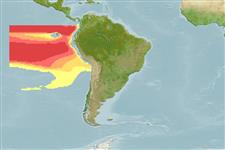>
Stomiiformes (Lightfishes and dragonfishes) >
Stomiidae (Barbeled dragonfishes) > Astronesthinae
Etymology: Astronesthes: Greek, astra = ray + Greek, esthes, -es = suit, something used to wrap (Ref. 45335); gibbsi: Named for R. Gibbs..
Environment: milieu / climate zone / depth range / distribution range
Ecología
marino; rango de profundidad 0 - 60 m (Ref. 41433). Tropical
Eastern Pacific: equatorial.
Tamaño / Peso / Age
Maturity: Lm ? range ? - ? cm
Max length : 7.1 cm SL macho / no sexado; (Ref. 41433)
Short description
Morfología | Morfometría
Vértebra: 46 - 47. Posterior edge of operculum with distinct concavity, bright tissue on operculum in the form of separate spots, sometimes are coalesced. Dorsal and ventral adipose fins present. Photophores in the following series: PV 12-14 (usually 12-13); VAV 16-18 (usually 17-18); OV 11-13 (usually 12); VAL 18-20; OA 30-32; OC 42-44; IA 39-42; IC 50-54 (Ref. 41433).
Life cycle and mating behavior
Madurez | Reproducción | Puesta | Huevos | Fecundidad | Larva
Borodulina, O.D., 1992. Description of a new mesopelagic fish, Astronesthes gibbsi, with notes on the closely related species, A. nigroides (Astronesthidae). J. Ichthyol. 32(7):111-117. (Ref. 41433)
IUCN Red List Status (Ref. 130435)
Threat to humans
Harmless
Human uses
Más información
Nombres comunesSinónimosMetabolismoDespredadoresEcotoxicologíaReproducciónMadurezPuestaAgregación para la puestaFecundidadHuevosEgg development
Age/SizeCrecimientoLength-weightLength-lengthLength-frequenciesMorfometríaMorfologíaLarvaDinámica larvariaReclutamientoAbundanciaBRUVS
ReferenciasAcuiculturaPerfil de acuiculturaRazasGenéticaElectrophoresesheritabilidadEnfermedadesProcesamientoNutrientsMass conversion
ColaboradoresImágenesStamps, Coins Misc.SonidosCiguateraVelocidadTipo de nataciónSuperficie branquialOtolitosCerebrosVisión
Herramientas
Special reports
Download XML
Fuentes de Internet
Estimates based on models
Phylogenetic diversity index (Ref.
82804): PD
50 = 0.5000 [Uniqueness, from 0.5 = low to 2.0 = high].
Bayesian length-weight: a=0.00417 (0.00171 - 0.01014), b=3.05 (2.83 - 3.27), in cm total length, based on LWR estimates for this (Sub)family-body shape (Ref.
93245).
Nivel trófico (Ref.
69278): 3.6 ±0.6 se; based on size and trophs of closest relatives
Resiliencia (Ref.
120179): Alto, población duplicada en un tiempo mínimo inferior a 15 meses (Preliminary K or Fecundity.).
Fishing Vulnerability (Ref.
59153): Low vulnerability (10 of 100).
